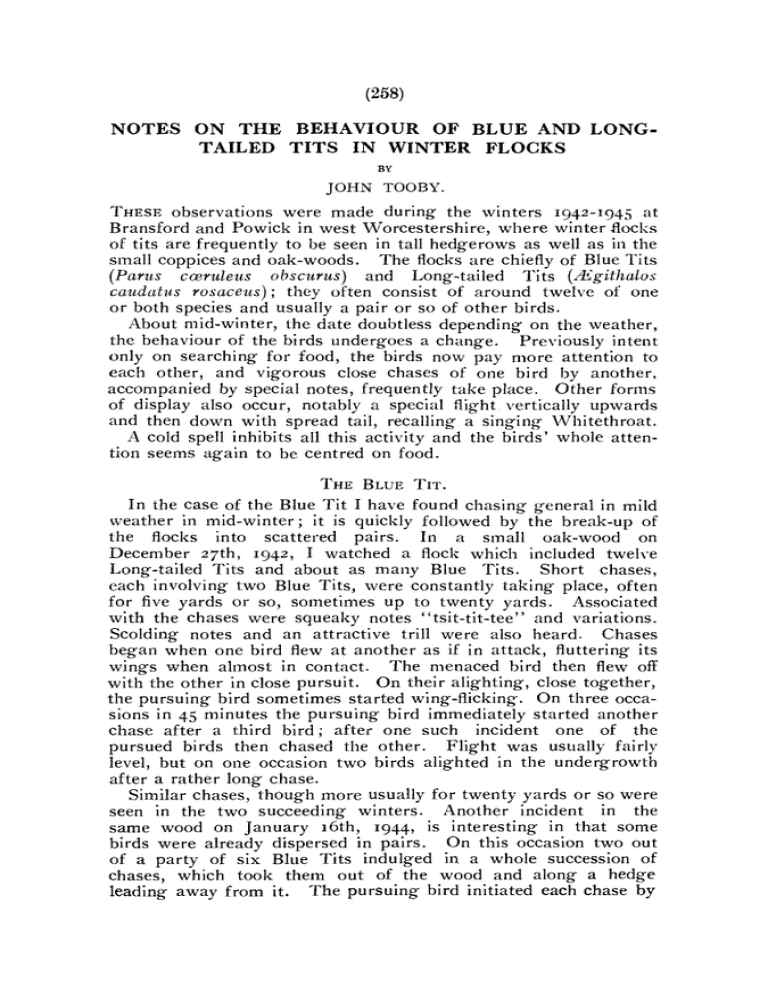NOTES ON THE BEHAVIOUR OF BLUE AND LONG
advertisement

(258) N O T E S O N T H E B E H A V I O U R OF B L U E A N D L O N G T A I L E D T I T S I N W I N T E R FLOCKS BY JOHN TOOBY. T H E S E observations were made during the winters 1942-1945 at Bransford and Powick in west Worcestershire, where winter flocks of tits are frequently to be seen in tall hedgerows as well as in the small coppices and oak-woods. The flocks are chiefly of Blue Tits (Paras cceruleus obscurus) and Long-tailed Tits (Aigithalos caudatus rosaceus); they often consist of around twelve of one or both species and usually a pair or so of other birds. About mid-winter, the date doubtless depending on the weather, the behaviour of the birds undergoes a change. Previously intent only on searching for food, the birds now pay more attention to each other, and vigorous close chases of one bird by another, accompanied by special notes, frequently take place. Other forms of display also occur, notably a special flight vertically upwards and then down with spread tail, recalling a singing Whitethroat. A cold spell inhibits all this activity and the birds' whole attention seems again to be centred on food. T H E BLUE TIT. In the case of the Blue Tit I have found chasing general in mild weather in mid-winter; it is quickly followed by the break-up of the flocks into scattered pairs. In a small oak-wood on December 27th, 1942, I watched a flock which included twelve Long-tailed Tits and about as many Blue Tits. Short chases, each involving two Blue Tits, were constantly taking place, often for five yards or so, sometimes up to twenty yards. Associated with the chases were squeaky notes "tsit-tit-tee" and variations. Scolding notes and an attractive trill were also heard. Chases began when one bird flew at another as if in attack, fluttering its wings when almost in contact. The menaced bird then flew off with the other in close pursuit. On their alighting, close together, the pursuing bird sometimes started wing-flicking. On three occasions in 45 minutes the pursuing bird immediately started another chase after a third bird; after one such incident one of the pursued birds then chased the other. Flight was usually fairly level, but on one occasion two birds alighted in the undergrowth after a rather long chase. Similar chases, though more usually for twenty yards or so were seen in the two succeeding winters. Another incident in the same wood on January 16th, 1944, is interesting in that some birds were already dispersed in pairs. On this occasion two out of a party of six Blue Tits indulged in a whole succession of chases, which took them out of the wood and along a hedge leading away from it. The pursuing bird initiated each chase by VOL. x i x ] N O T E S O N B L U E A N D L O N G - T A I L E D T I T S . 259 flying" at the other, but only following' closely for the first few yards. Finally the pursuing bird returned to the rest of the party in the woodT H E LONG-TAILED T I T . On the occasion previously referred to on December 27th, 1942, as on other occasions in succeeding Decembers, chases amongst the Long-tailed Tits were only seen at intervals. When they occurred, several often took place in quick succession. During these chases, a creaky " t s i t - t i t " with variations, e.g., "tseer-tseert s i t " , is uttered by one or other of the birds. The chases were usually for about twenty y a r d s ; on alighting, the leading bird usually flew off again almost at once; the pursuer sometimes followed but more often returned to the flock. Chases are sometimes started by one bird flying at another, after the manner of the Blue T i t ; at other times when several birds are on the wing together, one bird will suddenly put on speed and fly at another. Dispersal into separate pairs takes place later in the season than in the Blue Tit and is spread over a longer period. Pairs were seen on February 2nd, 1944, and a party of five on the following March 23rd. The quiet " s t a y - a t - h o m e " behaviour of the paired birds is in marked contrast to the excitement in the flocks in February and early March. At this time those Longtailed Tits that are still in flocks take part in excited chases which may take the participants for considerable distances in various directions. Display-flight and song may be indulged in by the birds in the intervals between chases. On March 7th, 1945, I was able to watch what was possibly the final dispersal of a party of six birds into three separate pairs. W h e n first seen three birds were taking part in wildly excited chases along the side of a low hedge. They soon joined the rest of the party in a thicket some 50 yards from where I stood. After some movement there one pair flew to the tall hedges of a green lane. The rest flew in the opposite direction to some clumps of brambles at the end of a steep gully. They immediately flew on to the low hedge, but when they reached a corner in the hedge one pair suddenly flew back to the gully, stopping for a short time at the thicket " e n r o u t e " . The other pair then worked their way quietly along the hedge towards the wood; they were flicking their wings and calling " t s i r r p " repeatedly. In all cases the birds seemed very much less excited in separate pairs than in the flock. On March 13th, I found three separate pairs, one in the gully, and two in different parts of the wood. This would seem to lend support to the inference that the party finally dispersed into separate pairs on March 7th. DISPLAY-FLIGHT. I have witnessed display-flights of the Long-tailed Tit on several occasions, most of them involving birds in the flock. On 260 BRITISH BIRDS. [VOL. XLI. January n t h , 1944, I watched a flock in a small oak-wood. Frequently one or other of the birds soared vertically upwards for 15 or 20'feet and then dived vertically down again. The tail was spread throughout so as to show the white edges. This display was sometimes performed by several birds in quick succession, so that three or four were often displaying simultaneously. A few chases took place on this occasion, none of them very vigorous. In my experience the birds do not usually soar so high, often only 4 or 6 feet, and sometimes the soaring upward part is omitted altogether. On one occasion a bird checked its descent several times, giving the effect of an aerial dance. I have a few records of this special flight from paired birds. A case of this with other points of interest occurred on February 14th, 1943; in various parts of a small orchard there were two Blue Tits which chased each other as described above, a pair of Blue Tits, a pair of Longtailed Tits and two pairs of Great Tits. After the chase was finished, one of the pair of Blue Tits performed a succession of display-flights similar to those of the Long-tailed Tit, though without any noticeable spreading of the tail. One of the pair of Long-tailed Tits then performed its display-flight several times and this was followed by an almost exact repetition on the part of one of the Great Tits. This bird fanned its tail to show off the white edges. Presumably the display is sufficiently similar in the three species for performance of it by one of them to stimulate the others to follow suit. COAL- AND MARSH-TITS. Coal-Tits (Parus ater britannicus) and Marsh-Tits (Parus palustris dresseri) are usually seen in pairs in my district. I have single observations on each of these species which may be of interest here. Chases, closely similar to those described above for the Blue and Long-tailed Tits occurred in a party of Marsh-Tits on July 24th, 1943, and in a party of Coal-Tits on September 19th, 1943; they were accompanied in both cases by calls noticeably similar to those used in the chases by the Blue and Long-tailed Tits. SUMMARY. In three successive winters a special form of behaviour in Blue Tits and in Long-tailed Tits has been observed to precede the dispersal of the winter flocks into separate pairs. Until more data are available, however, caution is needed in drawing any general conclusions.
